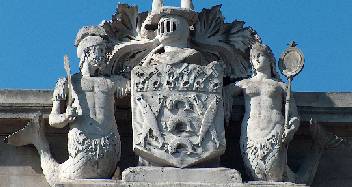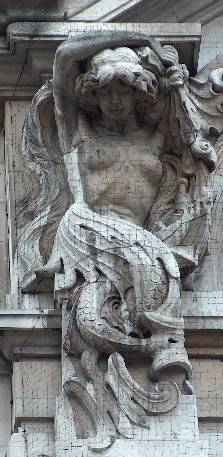
Before Victorian times, mermaid statues were often rather ungainly, inelegant things, looking fat or top heavy, but by the mid 19th Century there was an appreciation that a mermaid shold be well proportioned, like a human, so that the part below the waist should be not much less tall, or long, than the part above it. Indeed, in painting and above all illustration, mermaids could have far longer tail portions, giving a sinuous look, particularly suited to the art nouveau period, but this was uncommon in sculpture.
The typical Victorian mermaid transforms from girl to fish at the waist, with the lower part tapering gradually to the long, muscular tail, splayed at the end. Thus we have the whole girlish stomach, and if slender, as is often the case, the bones of the hips are shown, and below, we quickly move to scales. The proportions below the waist are often close to those of the human legs, so that we can look at a mermaid and imagine the nude figure with her legs together, and the tail fins more or less where her feet would be - an intrinsically satisfying proportion. However, it is acceptable to have a little less bulk below the waist then a human, or, with a long solid tail, rather more.
The second main form of mermaid has a split at leg height, and then there are two variants. Either it is emphasised that there is no thigh bone below, but rather two curly tails from that point with some sort of articulation as in the spine. These tails are usually coiled, and each bears its own separate pair of tailfins. Or there is is a straight thigh, as in a human, and it is from the knee down that there is a bonelessness and fishiness. Either is an acceptable form of the Triton (though we speak of triton typically as referring to the male), familiar from Roman mythology.
A third option is not to complete the lower half, but to have the mermaid dissolving away into, say, a pillar, or within a garland of flowers, much as a Greek stele dissolves away below the chest. Or the lower part can be grotesque, that is, becoming ornamental or flowery, suggestive of a tail, which is almost only the case for a relief rather than a mermaid in the round.
Finally, it is possible, though in my experience really rather rare, to have a sort of a centaur equivalent, with a separate pair of legs and a tail.
In physique, the mermaid is typically small breasted, but wide hipped, and either slender of arm or well muscled. The masculine form, the merman, is almost invariably highly muscular - for more examples, see the separate page. We can have mer-children too, which may be cherubic in proportion. We might think that a mermaid should have long, swirly hair, but it is equally common to have short hair, and with the mermen, we may have a Neptunelike beard or a smooth shaven chin.
Apart from the tailfin, we may have other fins as small, lateral ones like a seahorse has, round about waist level. Mermaids are of course nude, but sometimes have some sort of indeterminate gathering of seaweed or frilly fin at the waist to give the appearance of a short skirt.
The mermaid is of course utterly appropriate for a location connected with water, thus above all as part of a fountain, or sometimes at seaside locations. This gives opportunity for other sea life - shells, fishes, and waterhorses (hippogryphs). They also feature in some coats of arms, hence in church monuments, despite their pagan connotations. It is less obvious why they feature at, say, Victoria Station, but they certainly do lend themselves to a role as supports of overhanging roofs and pedimental features, as is the case at Victoria.
 Victoria Station mermaid in a supporting role.
Victoria Station mermaid in a supporting role.
We should note that the mermaid, after fading out in the First World War like so many figural things, had a renaissance later in the 20th Century, in a variety of particularly lovely forms, the creation of Gilbert Bayes, Charles Wheeler and others.
Visits to this page from 21 Nov 2011: 18,666
Sculpture pages // Mermen and Tritons // Angel Statues // Statues of Warrior Women // Sphinx Statues // Cherubs